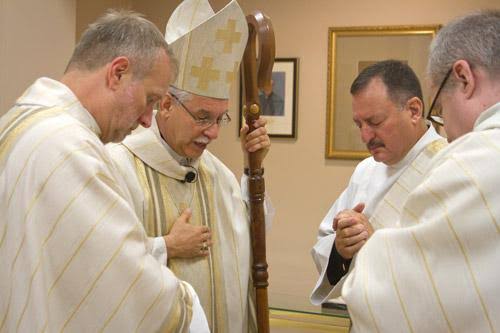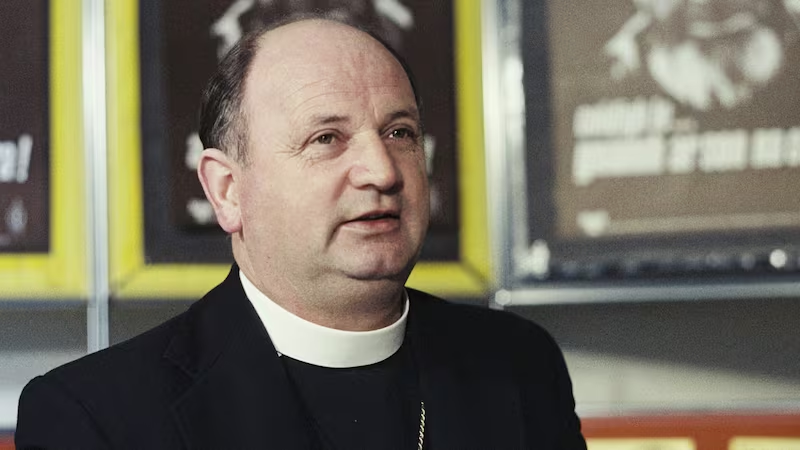For decades he was the Catholic Church’s most charismatic figure in Ireland. He highlighted homelessness and poverty. He drove fast cars and stopped to sing songs with the public as he went about his merry way. That was the public face of Bishop Eamonn Casey.
In his work as chairman of the development agency Trocaire, he was not afraid to put the wind up various Irish cabinet ministers and attack American foreign policy towards poor countries such as El Salvador.
But even at the height of his powers, before his life became mired in scandal, there were those who questioned whether the slogan of Trocaire – ‘Live simply so others may simply live’ – was entirely suitable for a man like Eamonn Casey.
Bishop Casey’s life was anything but simple. He liked to eat in fancy restaurants and drive sports cars at alarming speed. He boasted to his lover, Annie Murphy, that he could dance like Fred Astaire.
By the mid-1980s, his celebrity had reached such celestial heights that RTE offered him a slot for one night hosting the Saturday Live chatshow. He regaled his audience with ‘come-all-ye’ songs and boasted that he knew 400 ballads off by heart.
Like his friend Fr Michael Cleary, who joined him as the warm-up act at the Papal Mass in Galway in 1979, Casey was the bridge between the fusty and reserved old world of the hierarchy, stuck in the 1950s, and the modern media world of soundbites, chat shows and talk radio.
Casey and Cleary, with their populist touch and crowd-pleasing manner, were seen at the time as standard-bearers for the more youthful Church of the future. But this was to unravel in spectacular fashion when news emerged much later of their sons and lovers.
The story of Casey’s affair with American Annie Murphy and how he fathered a son, Peter, helped to shatter the Church’s reputation as the ultimate arbiter of moral values. More recently, in the years before and since his death, Bishop Casey has enjoyed something of a rehabilitation.
Despite his neglect of his son, the Annie Murphy affair was seen as the relatively innocent prelude to a series of much more sinister scandals engulfing the Church, particularly those involving child rape and subsequent attempts to cover it up.
Casey’s work among homeless Irish emigrants in London and among the poor of the developing world caused many to forgive his playboy bishop peccadilloes.
The purple prose of Annie Murphy’s account of the affair in her heavily ghost-written book, Forbidden Fruit, at times teetered on the brink of comedy: “There stood the bishop, my love, without clerical collar or crucifix or episcopal ring, without covering of any kind. The great showman had unwrapped himself. I witnessed a great hunger. This was an Irish famine of the flesh.”
In the light of the scandal that followed, many wondered where there was harm in a tryst involving consenting adults, but the story of the bishop’s life has now taken on a much darker aspect – with reports of allegations of child abuse.
His niece, Patricia Donovan, now aged 56, alleges she was sexually abused by Casey over an extended period from the age of five. She said she reported this to police in 2005.
The allegations were investigated in 2006, but the Irish director of public prosecutions ordered that no charges be brought on 13 sample allegations.
These allegations were reported in the media in 2006, but Patricia Donovan was not named at the time.
It also emerged this week that other accusations of child abuse had been made against Casey from his time as a young priest in the 1950s and 1960s.
In one of the cases, an alleged victim was reported to have made a claim through the Residential Institutions Redress Board, and received compensation.
In the other case, it was reported that a settlement had been made after Casey’s death. A woman had begun court proceedings alleging abuse during the time when he was a young curate in St John’s Cathedral in Limerick from 1955 to 1960.
Although he was to rise to become one of the Church’s prominent stars, Casey did not enter the priesthood as a young man with a startling vocation.
Born in Firies in Kerry, he was the son of a creamery worker, and grew up in Adare, Co Limerick. A local priest put him down for St Munchin’s, the diocesan seminary in Limerick, without even telling him or his father of his destiny. He studied there and moved on to the seminary in Maynooth.
He later acknowledged, after the Annie Murphy scandal emerged, that he struggled with celibacy, particularly when he lived in London – and he traced this back to his time in Maynooth.
In an interview with Veronica Guerin in 1993, Casey recalled how he had sought help.
“Celibacy was unquestionably a factor,” he said. “Two or three times in my seven years at Maynooth, it became very much a factor. I had to engage in serious counselling sessions. There were no girls involved at the time.
“It wasn’t that I was looking for female company, or a sexual experience, but working outside – pastoral work – disorientated me for a while.”
In his first job as a curate in Limerick, he took an interest in social causes, including poverty and emigration.
According to one account of his time in the city, he learnt about a “widespread vice ring using young boys for sexual purposes”.
His interest in Irish emigrants took him to England, where he honed his skills as a campaigner against homelessness.
He said in one interview: “One of the things that celibacy does for you is that it doubles and trebles your time.”
In fact, as he revealed to Annie Murphy during their affair, Casey had plenty of time for activism, because he could get by on just five hours’ sleep.
His appearance in Cathy Come Home, Ken Loach’s harrowing TV drama about the homeless, helped to raise his profile, and in 1969 he returned to his native county to become Ireland’s youngest bishop.
Not everyone was impressed. The current affairs magazine Hibernia reported in 1974 that “since being made Bishop of Kerry, Casey has built up a reputation for fast cars and frequent absences from his diocese; a child in catechism class once said that the difference between God and Bishop Casey is that while God is everywhere, Bishop Casey is everywhere except in Kerry.”
The Diocese of Kerry this week revealed it had handled one allegation of sexual abuse of a child by Casey. It said: “Given that information relating to Bishop Casey is now in the public domain, we can confirm that one historical concern regarding was received by the diocese.
“This information was forwarded to the gardai … and the person concerned was offered support by the diocese.”
When he became Bishop of Galway in 1976, Casey continued his social activism through his work with Trocaire and by campaigning for accommodation for Travellers. He may have campaigned on issues such as poverty at home and abroad, and his manner was informal, but he was not so progressive on doctrinal issues, according to Sean McDonagh of the Association of Catholic Priests.
“He was radical enough on social issues but, theologically, he wasn’t radical in any sense of the word,” he says.
During this period, the issue of single unmarried mothers and “illegitimate children” seemed to preoccupy Casey – he was a patron of Cherish, the group that helped unmarried mothers and their children.
As the saying goes, hypocrisy is the tribute vice pays to virtue. Perhaps the plight of his own son was preying on his conscience.
But when Annie Murphy was pregnant with his child four years previously, and subsequently gave birth, the bishop showed little sign of wanting to cherish either mother or child.
Both before and after the birth, he pleaded with her to give the child up for adoption as a way to “cleanse” herself.
“The minute I laid eyes on and held my son, I knew there was no way I was going to give him up,” she later wrote of the birth.
After the delivery, Casey paid several fraught visits to the hospital, often with adoption papers in hand, still trying to persuade Annie to change her mind.
She was told that if she gave the baby up, she could stay “closer to God”.
Years later, she appeared on RTE’s Late Late Show to talk about the affair and her book.

















